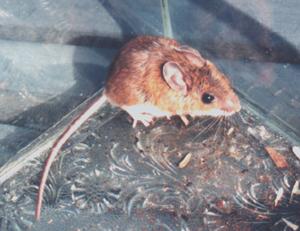Checklist of the Mammals of the Ottawa District
MARSUPIALSDidelphis virginiana, Virginia opossum: some records close to the District
INSECTIVORES
§ Sorex cinereus, common shrew: abundant
§ S.fumeus, smoky shrew: uncommon
§ S.hoyi, pygmy shrew: rare
§ S.palustris, water shrew: very rare
§ Blarina brevicauda, northern short-tailed shrew: abundant
§ Parascalops breweri, hairy-tailed mole: rare
§ Condylura cristata, star-nosed mole: common
BATS
§ Myotis leibii, eastern small-footed bat: very rare
§ M.lucifugus, little brown bat: common
§ M.septentrionalis, northern long-eared bat: rare
§ Lasionycteris noctivagans, silver-haired bat: rare June-August migrant
§ Pipistrellus subflavus, eastern pipistrelle: very rare
§ Eptesicus fuscus, big brown bat: common
§ Lasiurus borealis, eastern red bat: rare summer migrant
§ L.cinereus, hoary bat: uncommon summer migrant
RABBITS AND HARES
§ Sylvilagus floridanus, eastern cottontail: unknown before 1931, now common
§ Lepus americanus, snowshoe hare: common
§ L.europaeus, European hare: rare, probably escapes
RODENTS
Squirrels
§ Tamias striatus, eastern chipmunk: abundant, hibernates winter
§ Marmota monax, woodchuck: abundant, hibernates winter
§ Sciurus carolinensis, gray squirrel: black and gray phases abundant
§ Tamiasciurus hudsonicus, red squirrel: common
§ Glaucomys sabrinus, northern flying squirrel: common
§ G.volans, southern flying squirrel: uncommon
Beavers
§ Castor canadensis, beaver: common
New World Rats & Mice
§ Peromyscus leucopus, white-footed mouse: abundant
§ P.maniculatus, deer mouse: common
§ Clethrionomys gapperi, southern red-backed vole: common
§ Microtus pennsylvanicus, meadow vole: abundant
§ Ondatra zibethicus, muskrat: common
§ Synaptomys cooperi, southern bog lemming: very rare
Old World Rats & Mice
§ Rattus norvegicus, Norway rat: uncommon
§ Mus musculus, house mouse: uncommon
Jumping Mice
§ Zapus hudsonius, meadow jumping mouse: uncommon, hibernates winter
§ Napaeozapus insignis, woodland jumping mouse: uncommon, hibernates winter
Porcupines
§ Erethizon dorsatum, porcupine: common
Myocastrids
Myocastor coypus, nutria or coypu: escapes, don't survive winter
PRIMATES
§ Homo sapiens, us: abundant
CARNIVORES
Wolves and Foxes
§ Canis latrans, coyote: uncommon
§ C.lupus, gray wolf: uncommon in Quebec, rare in Ontario
§ Vulpes vulpes, red fox: common
Bears and Raccoons
§ Ursus americanus, black bear: uncommon
§ Procyon lotor, raccoon: abundant
Mustelids
§ Martes americana, marten: very rare
§ M.pennanti, fisher: extirpated locally, now rare (being re-introduced)
§ Mustela erminea, ermine: common
§ M.frenata, long-tailed weasel: uncommon
§ M.vison, mink: common
§ Gulo gulo, wolverine: one extraterritorial record, Quebec, a second near North Gower in 2004.
Taxidea taxus, badger: a record close to District
§ Mephitis mephitis, striped skunk: common
§ Lontra canadensis, river otter: uncommon
Cats
§ Felis concolor, cougar: very rare (two kits were born and successfully raised in the wild near Carlsbad Springs and dispersed naturally late 2003)
F.catus, domestic cat: rarely fully feral, few survive winter unaided
§ Lynx canadensis, Canada lynx: very rare
§ L.rufus, bobcat: very rare
SEALS
Phoca vitulina, harbor seal: no records since 1884 (when the Ottawa River was blocked by a dam)
DEER
Cervus elaphus, wapiti (elk): extirpated locally by 1800
§ Odocoileus virginianus, white-tailed deer: common
§ Alces alces, moose: rare
Rangifer tarandus, caribou: extirpated locally by 1900
§ - may occur naturally in the wild in the District today
abundant - present almost everywhere in large numbers
common - present almost everywhere
uncommon - local in distribution, found in 10% or less of the area of the District
rare - very local, not present in much suitable habitat
very rare - only a few scattered records
Notes
The checklist status of many organisms, birds for example, is usually stated in terms of how easily they can be observed. However, a major part of the life skills of most mammals, small ones in particular, consists in evading the notice of all larger organisms. For the most part, they are seen only by patient and determined observers, or by trappers. The status used here is an attempt to indicate their actual numbers, not the numbers that will be seen by a casual observer, even though these will not be agreed upon by all.
The status of one mammal is in particular dispute. The official position of the provincial Ministry of Natural Resources is that the eastern race of cougar was extinct by the mid 1800's, and that every sighting since then is an escape from the pet trade (western or South American races) or mistaken identity. A look at the vastness of potential territory for these animals in northern Ontario, and the tiny extent of human intrusion there, should give one pause before accepting such a black and white dictum. The number of observations currently being reported from northern Ontario seems in excess of those expected from escapes. Western cougars could have crossed the continent through the boreal forest of the northern prairies in only a few decades with their wide-ranging habits, and descendants of those should be considered natural. Nevertheless, the Atlas regrettably felt constrained to suppress all data on the more than 600 records they received of this species.
Fortunately, the modern Internet makes it easy to defeat such censorship. The Ontario Puma Foundation is now collecting and publishing cougar sightings throughout the province, including a case near Carlsbad Springs when a female successfully raised two young who dispersed normally. I thank Dr.D.A.Smith for helpful suggestions during the preparation of this list.
References:
'Mammals of the Ottawa District', A.L.Rand, The Canadian Field-Naturalist 59(4):111-132 (1945)
'Atlas of the Mammals of Ontario', J.Dobbyn, Federation of Ontario Naturalists (1994)

a snowshoe hare in early spring

a woodchuck - abundant means feeling at home just about everywhere

a red squirrel who has learned to not evade the notice of people at a picnic site

a chipmunk cleaning up under a bird feeder

a raccoon

an adult deer mouse, showing the bi-coloured tail that usually separates it from the white-footed mouse

a short-tailed shrew, moving quickly as usual

a cottontail rabbit